Individual Assignment: Financial Principles and Analysis (FNCE5008)
VerifiedAdded on 2022/10/06
|8
|1798
|6
Homework Assignment
AI Summary
This assignment provides a comprehensive analysis of financial principles, covering key concepts such as incremental free cash flows, depreciation, discounting rates, capital budgeting techniques, and mutually exclusive projects. The solution begins with calculating incremental free cash flows over a four-year period, incorporating initial investment, sales, variable costs, expenses, and tax implications. It then addresses the concept of depreciation, explaining its impact on asset valuation and cash flow calculations. The assignment further explores discounting rates, using a rate of 16% to determine present values, and delves into capital budgeting techniques, including net present value (NPV), internal rate of return (IRR), payback period, and profitability index, to evaluate the feasibility of a project. Finally, the assignment examines mutually exclusive projects, emphasizing the selection of the project with the highest NPV or IRR, or the shortest payback period, and applying these principles to a case study involving Hoosier Racing Tyre Company. The solution includes detailed calculations, explanations, and references to support the financial analysis.
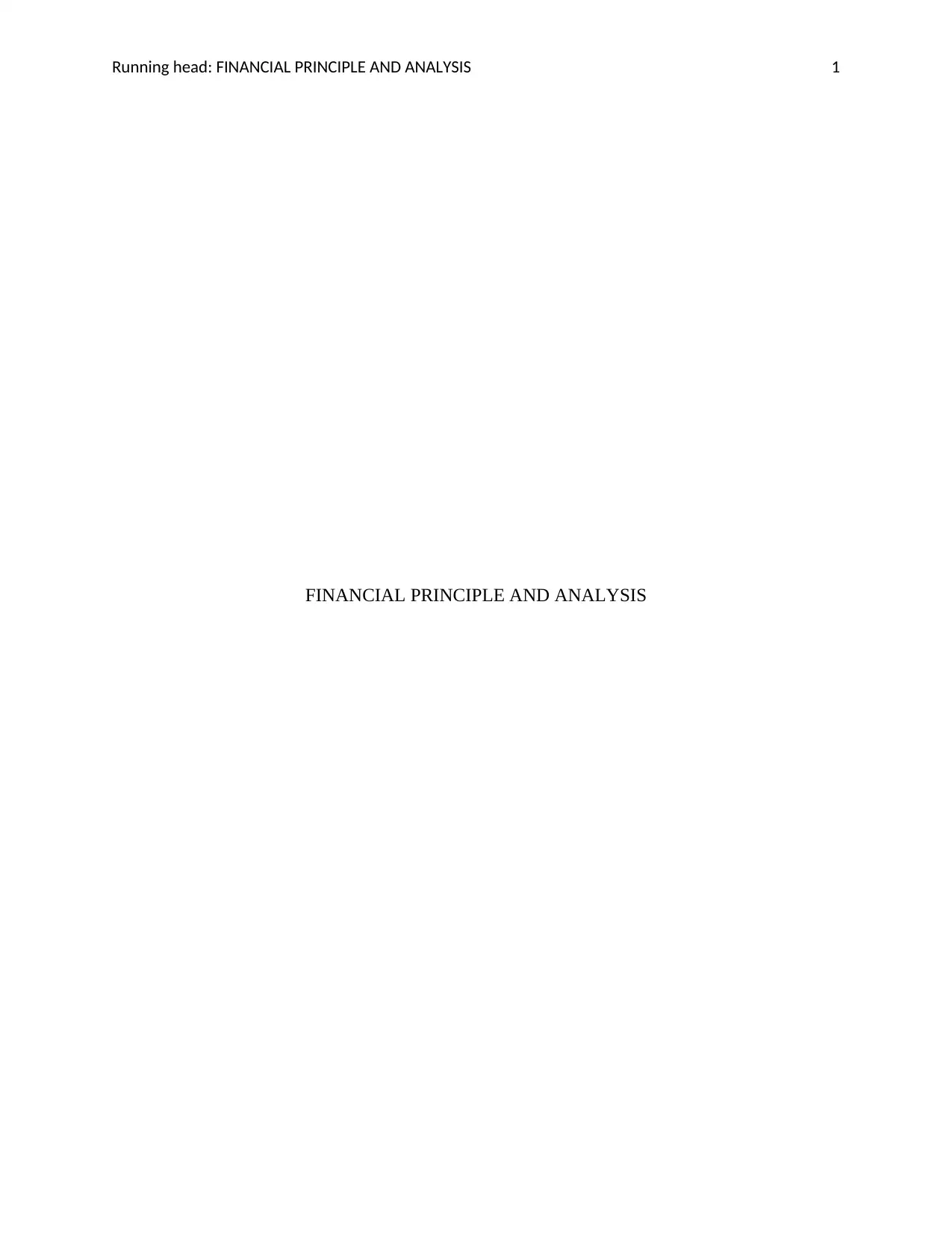
Running head: FINANCIAL PRINCIPLE AND ANALYSIS 1
FINANCIAL PRINCIPLE AND ANALYSIS
FINANCIAL PRINCIPLE AND ANALYSIS
Paraphrase This Document
Need a fresh take? Get an instant paraphrase of this document with our AI Paraphraser
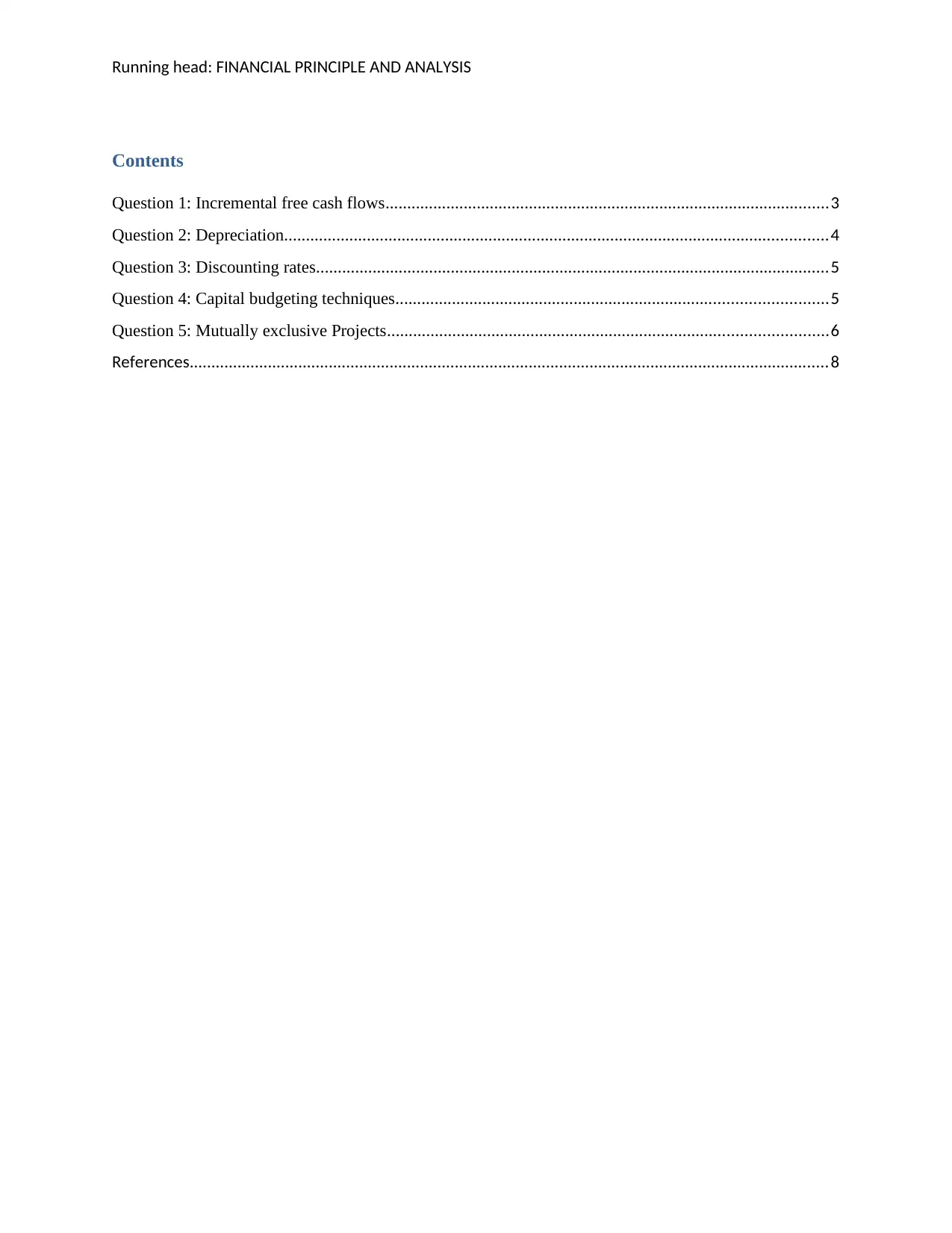
Running head: FINANCIAL PRINCIPLE AND ANALYSIS
Contents
Question 1: Incremental free cash flows......................................................................................................3
Question 2: Depreciation.............................................................................................................................4
Question 3: Discounting rates......................................................................................................................5
Question 4: Capital budgeting techniques...................................................................................................5
Question 5: Mutually exclusive Projects.....................................................................................................6
References...................................................................................................................................................8
Contents
Question 1: Incremental free cash flows......................................................................................................3
Question 2: Depreciation.............................................................................................................................4
Question 3: Discounting rates......................................................................................................................5
Question 4: Capital budgeting techniques...................................................................................................5
Question 5: Mutually exclusive Projects.....................................................................................................6
References...................................................................................................................................................8
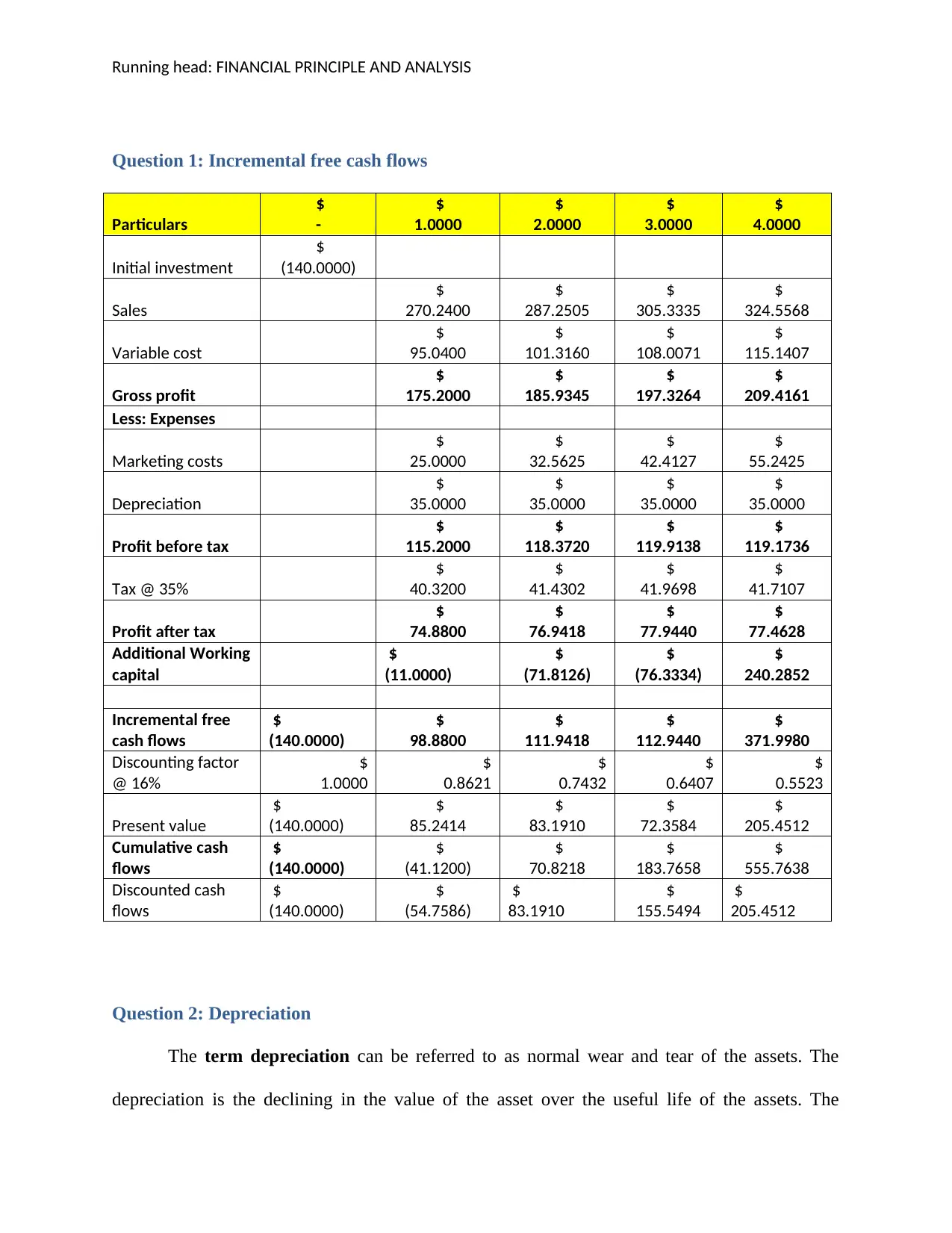
Running head: FINANCIAL PRINCIPLE AND ANALYSIS
Question 1: Incremental free cash flows
Particulars
$
-
$
1.0000
$
2.0000
$
3.0000
$
4.0000
Initial investment
$
(140.0000)
Sales
$
270.2400
$
287.2505
$
305.3335
$
324.5568
Variable cost
$
95.0400
$
101.3160
$
108.0071
$
115.1407
Gross profit
$
175.2000
$
185.9345
$
197.3264
$
209.4161
Less: Expenses
Marketing costs
$
25.0000
$
32.5625
$
42.4127
$
55.2425
Depreciation
$
35.0000
$
35.0000
$
35.0000
$
35.0000
Profit before tax
$
115.2000
$
118.3720
$
119.9138
$
119.1736
Tax @ 35%
$
40.3200
$
41.4302
$
41.9698
$
41.7107
Profit after tax
$
74.8800
$
76.9418
$
77.9440
$
77.4628
Additional Working
capital
$
(11.0000)
$
(71.8126)
$
(76.3334)
$
240.2852
Incremental free
cash flows
$
(140.0000)
$
98.8800
$
111.9418
$
112.9440
$
371.9980
Discounting factor
@ 16%
$
1.0000
$
0.8621
$
0.7432
$
0.6407
$
0.5523
Present value
$
(140.0000)
$
85.2414
$
83.1910
$
72.3584
$
205.4512
Cumulative cash
flows
$
(140.0000)
$
(41.1200)
$
70.8218
$
183.7658
$
555.7638
Discounted cash
flows
$
(140.0000)
$
(54.7586)
$
83.1910
$
155.5494
$
205.4512
Question 2: Depreciation
The term depreciation can be referred to as normal wear and tear of the assets. The
depreciation is the declining in the value of the asset over the useful life of the assets. The
Question 1: Incremental free cash flows
Particulars
$
-
$
1.0000
$
2.0000
$
3.0000
$
4.0000
Initial investment
$
(140.0000)
Sales
$
270.2400
$
287.2505
$
305.3335
$
324.5568
Variable cost
$
95.0400
$
101.3160
$
108.0071
$
115.1407
Gross profit
$
175.2000
$
185.9345
$
197.3264
$
209.4161
Less: Expenses
Marketing costs
$
25.0000
$
32.5625
$
42.4127
$
55.2425
Depreciation
$
35.0000
$
35.0000
$
35.0000
$
35.0000
Profit before tax
$
115.2000
$
118.3720
$
119.9138
$
119.1736
Tax @ 35%
$
40.3200
$
41.4302
$
41.9698
$
41.7107
Profit after tax
$
74.8800
$
76.9418
$
77.9440
$
77.4628
Additional Working
capital
$
(11.0000)
$
(71.8126)
$
(76.3334)
$
240.2852
Incremental free
cash flows
$
(140.0000)
$
98.8800
$
111.9418
$
112.9440
$
371.9980
Discounting factor
@ 16%
$
1.0000
$
0.8621
$
0.7432
$
0.6407
$
0.5523
Present value
$
(140.0000)
$
85.2414
$
83.1910
$
72.3584
$
205.4512
Cumulative cash
flows
$
(140.0000)
$
(41.1200)
$
70.8218
$
183.7658
$
555.7638
Discounted cash
flows
$
(140.0000)
$
(54.7586)
$
83.1910
$
155.5494
$
205.4512
Question 2: Depreciation
The term depreciation can be referred to as normal wear and tear of the assets. The
depreciation is the declining in the value of the asset over the useful life of the assets. The
⊘ This is a preview!⊘
Do you want full access?
Subscribe today to unlock all pages.

Trusted by 1+ million students worldwide
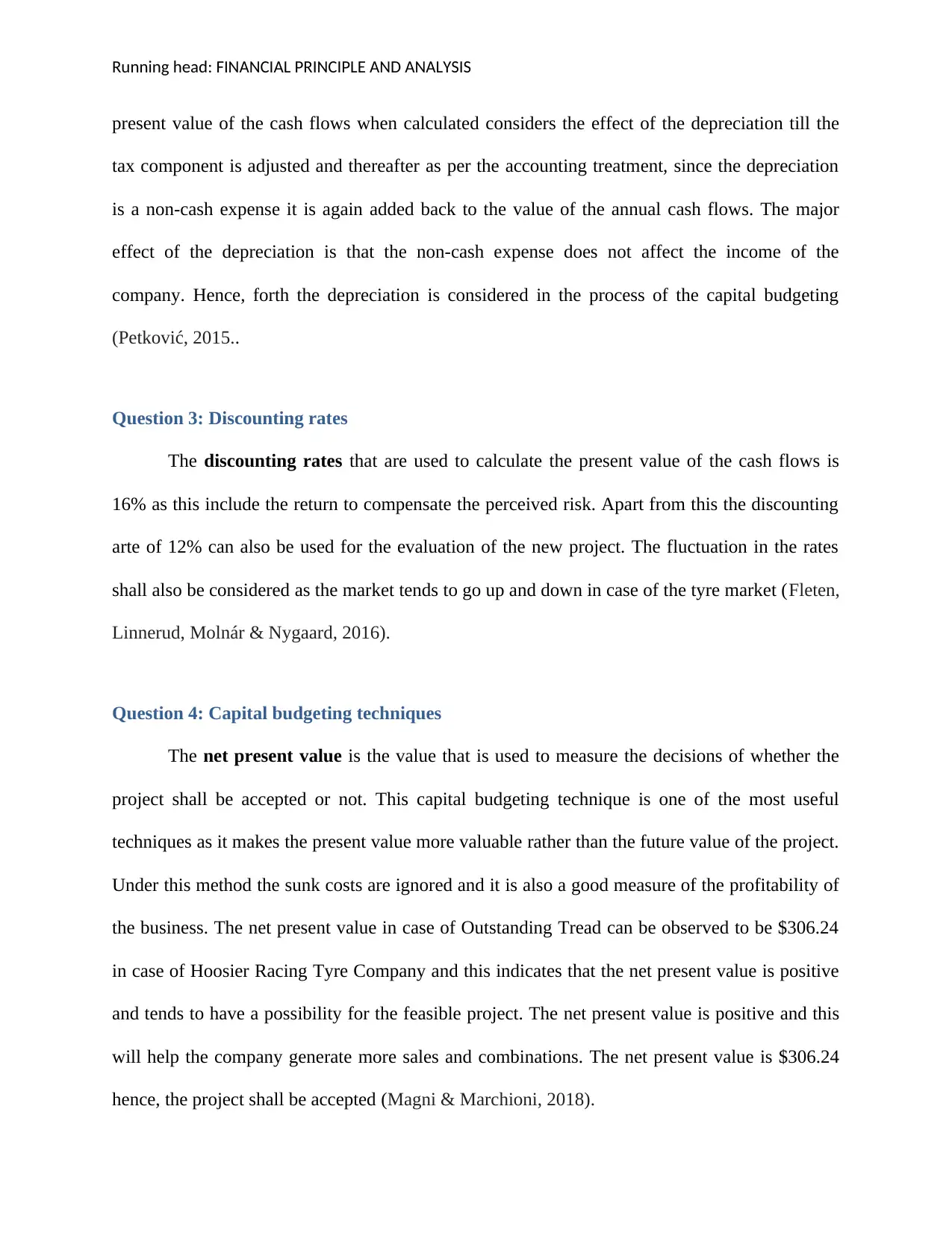
Running head: FINANCIAL PRINCIPLE AND ANALYSIS
present value of the cash flows when calculated considers the effect of the depreciation till the
tax component is adjusted and thereafter as per the accounting treatment, since the depreciation
is a non-cash expense it is again added back to the value of the annual cash flows. The major
effect of the depreciation is that the non-cash expense does not affect the income of the
company. Hence, forth the depreciation is considered in the process of the capital budgeting
(Petković, 2015..
Question 3: Discounting rates
The discounting rates that are used to calculate the present value of the cash flows is
16% as this include the return to compensate the perceived risk. Apart from this the discounting
arte of 12% can also be used for the evaluation of the new project. The fluctuation in the rates
shall also be considered as the market tends to go up and down in case of the tyre market (Fleten,
Linnerud, Molnár & Nygaard, 2016).
Question 4: Capital budgeting techniques
The net present value is the value that is used to measure the decisions of whether the
project shall be accepted or not. This capital budgeting technique is one of the most useful
techniques as it makes the present value more valuable rather than the future value of the project.
Under this method the sunk costs are ignored and it is also a good measure of the profitability of
the business. The net present value in case of Outstanding Tread can be observed to be $306.24
in case of Hoosier Racing Tyre Company and this indicates that the net present value is positive
and tends to have a possibility for the feasible project. The net present value is positive and this
will help the company generate more sales and combinations. The net present value is $306.24
hence, the project shall be accepted (Magni & Marchioni, 2018).
present value of the cash flows when calculated considers the effect of the depreciation till the
tax component is adjusted and thereafter as per the accounting treatment, since the depreciation
is a non-cash expense it is again added back to the value of the annual cash flows. The major
effect of the depreciation is that the non-cash expense does not affect the income of the
company. Hence, forth the depreciation is considered in the process of the capital budgeting
(Petković, 2015..
Question 3: Discounting rates
The discounting rates that are used to calculate the present value of the cash flows is
16% as this include the return to compensate the perceived risk. Apart from this the discounting
arte of 12% can also be used for the evaluation of the new project. The fluctuation in the rates
shall also be considered as the market tends to go up and down in case of the tyre market (Fleten,
Linnerud, Molnár & Nygaard, 2016).
Question 4: Capital budgeting techniques
The net present value is the value that is used to measure the decisions of whether the
project shall be accepted or not. This capital budgeting technique is one of the most useful
techniques as it makes the present value more valuable rather than the future value of the project.
Under this method the sunk costs are ignored and it is also a good measure of the profitability of
the business. The net present value in case of Outstanding Tread can be observed to be $306.24
in case of Hoosier Racing Tyre Company and this indicates that the net present value is positive
and tends to have a possibility for the feasible project. The net present value is positive and this
will help the company generate more sales and combinations. The net present value is $306.24
hence, the project shall be accepted (Magni & Marchioni, 2018).
Paraphrase This Document
Need a fresh take? Get an instant paraphrase of this document with our AI Paraphraser
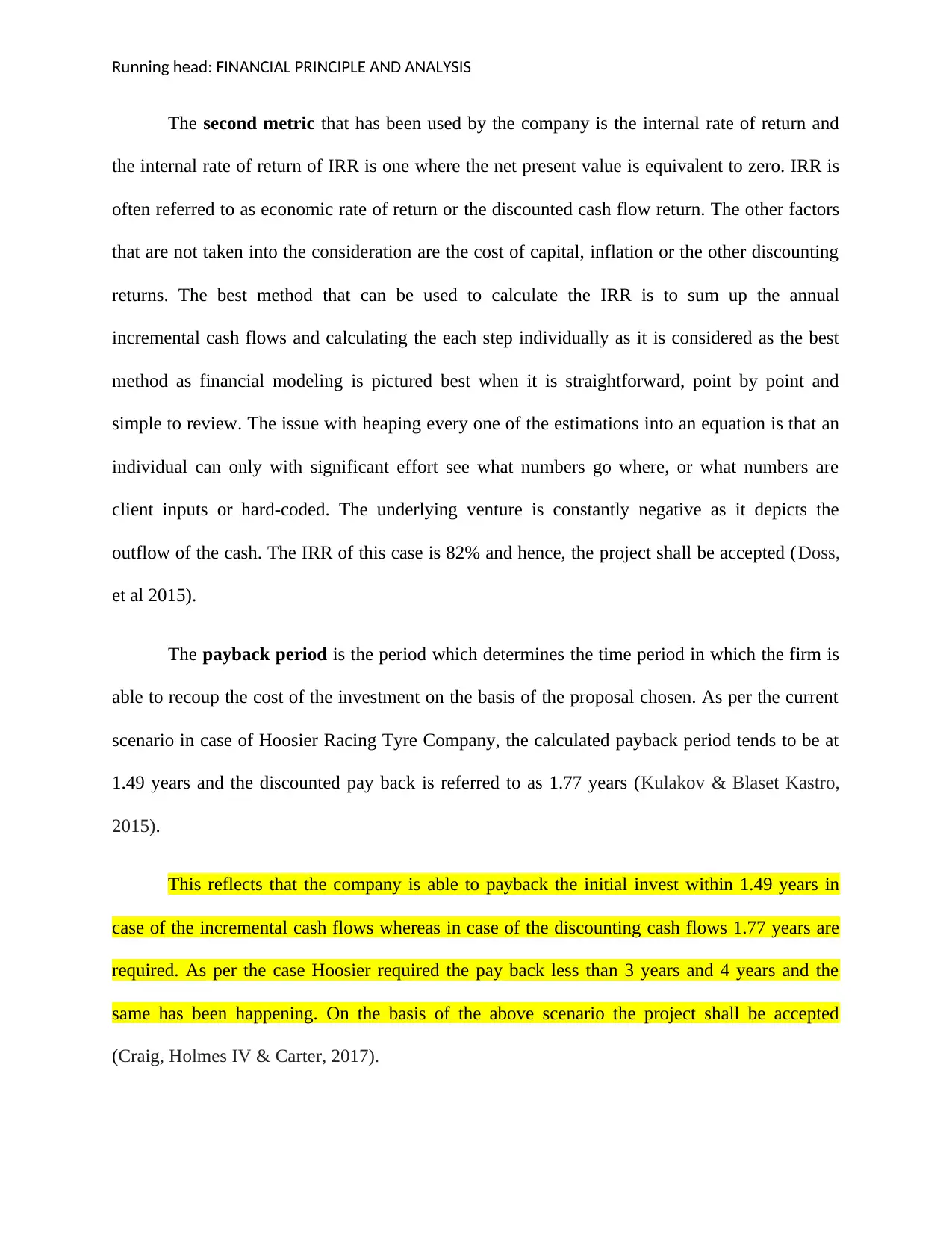
Running head: FINANCIAL PRINCIPLE AND ANALYSIS
The second metric that has been used by the company is the internal rate of return and
the internal rate of return of IRR is one where the net present value is equivalent to zero. IRR is
often referred to as economic rate of return or the discounted cash flow return. The other factors
that are not taken into the consideration are the cost of capital, inflation or the other discounting
returns. The best method that can be used to calculate the IRR is to sum up the annual
incremental cash flows and calculating the each step individually as it is considered as the best
method as financial modeling is pictured best when it is straightforward, point by point and
simple to review. The issue with heaping every one of the estimations into an equation is that an
individual can only with significant effort see what numbers go where, or what numbers are
client inputs or hard-coded. The underlying venture is constantly negative as it depicts the
outflow of the cash. The IRR of this case is 82% and hence, the project shall be accepted (Doss,
et al 2015).
The payback period is the period which determines the time period in which the firm is
able to recoup the cost of the investment on the basis of the proposal chosen. As per the current
scenario in case of Hoosier Racing Tyre Company, the calculated payback period tends to be at
1.49 years and the discounted pay back is referred to as 1.77 years (Kulakov & Blaset Kastro,
2015).
This reflects that the company is able to payback the initial invest within 1.49 years in
case of the incremental cash flows whereas in case of the discounting cash flows 1.77 years are
required. As per the case Hoosier required the pay back less than 3 years and 4 years and the
same has been happening. On the basis of the above scenario the project shall be accepted
(Craig, Holmes IV & Carter, 2017).
The second metric that has been used by the company is the internal rate of return and
the internal rate of return of IRR is one where the net present value is equivalent to zero. IRR is
often referred to as economic rate of return or the discounted cash flow return. The other factors
that are not taken into the consideration are the cost of capital, inflation or the other discounting
returns. The best method that can be used to calculate the IRR is to sum up the annual
incremental cash flows and calculating the each step individually as it is considered as the best
method as financial modeling is pictured best when it is straightforward, point by point and
simple to review. The issue with heaping every one of the estimations into an equation is that an
individual can only with significant effort see what numbers go where, or what numbers are
client inputs or hard-coded. The underlying venture is constantly negative as it depicts the
outflow of the cash. The IRR of this case is 82% and hence, the project shall be accepted (Doss,
et al 2015).
The payback period is the period which determines the time period in which the firm is
able to recoup the cost of the investment on the basis of the proposal chosen. As per the current
scenario in case of Hoosier Racing Tyre Company, the calculated payback period tends to be at
1.49 years and the discounted pay back is referred to as 1.77 years (Kulakov & Blaset Kastro,
2015).
This reflects that the company is able to payback the initial invest within 1.49 years in
case of the incremental cash flows whereas in case of the discounting cash flows 1.77 years are
required. As per the case Hoosier required the pay back less than 3 years and 4 years and the
same has been happening. On the basis of the above scenario the project shall be accepted
(Craig, Holmes IV & Carter, 2017).
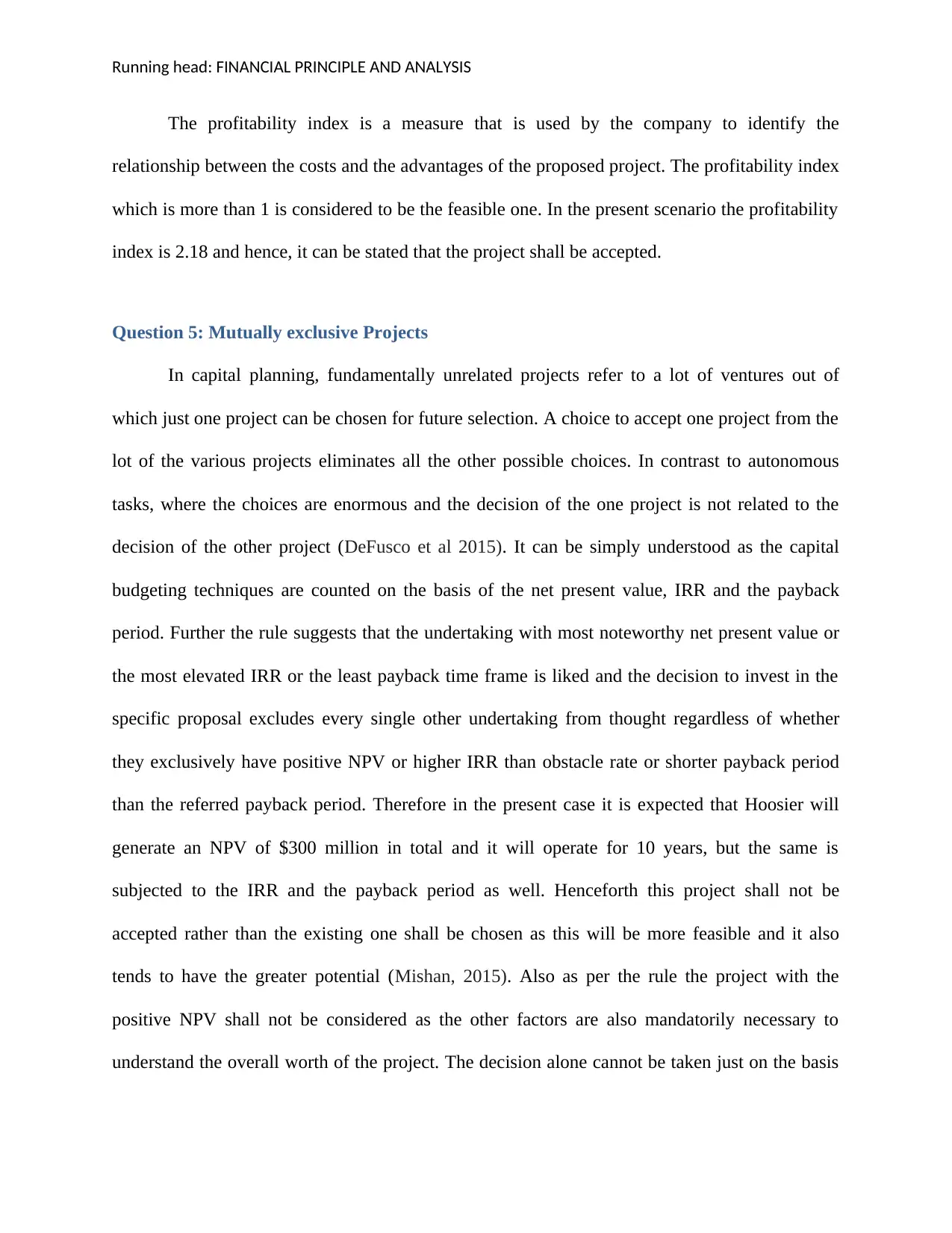
Running head: FINANCIAL PRINCIPLE AND ANALYSIS
The profitability index is a measure that is used by the company to identify the
relationship between the costs and the advantages of the proposed project. The profitability index
which is more than 1 is considered to be the feasible one. In the present scenario the profitability
index is 2.18 and hence, it can be stated that the project shall be accepted.
Question 5: Mutually exclusive Projects
In capital planning, fundamentally unrelated projects refer to a lot of ventures out of
which just one project can be chosen for future selection. A choice to accept one project from the
lot of the various projects eliminates all the other possible choices. In contrast to autonomous
tasks, where the choices are enormous and the decision of the one project is not related to the
decision of the other project (DeFusco et al 2015). It can be simply understood as the capital
budgeting techniques are counted on the basis of the net present value, IRR and the payback
period. Further the rule suggests that the undertaking with most noteworthy net present value or
the most elevated IRR or the least payback time frame is liked and the decision to invest in the
specific proposal excludes every single other undertaking from thought regardless of whether
they exclusively have positive NPV or higher IRR than obstacle rate or shorter payback period
than the referred payback period. Therefore in the present case it is expected that Hoosier will
generate an NPV of $300 million in total and it will operate for 10 years, but the same is
subjected to the IRR and the payback period as well. Henceforth this project shall not be
accepted rather than the existing one shall be chosen as this will be more feasible and it also
tends to have the greater potential (Mishan, 2015). Also as per the rule the project with the
positive NPV shall not be considered as the other factors are also mandatorily necessary to
understand the overall worth of the project. The decision alone cannot be taken just on the basis
The profitability index is a measure that is used by the company to identify the
relationship between the costs and the advantages of the proposed project. The profitability index
which is more than 1 is considered to be the feasible one. In the present scenario the profitability
index is 2.18 and hence, it can be stated that the project shall be accepted.
Question 5: Mutually exclusive Projects
In capital planning, fundamentally unrelated projects refer to a lot of ventures out of
which just one project can be chosen for future selection. A choice to accept one project from the
lot of the various projects eliminates all the other possible choices. In contrast to autonomous
tasks, where the choices are enormous and the decision of the one project is not related to the
decision of the other project (DeFusco et al 2015). It can be simply understood as the capital
budgeting techniques are counted on the basis of the net present value, IRR and the payback
period. Further the rule suggests that the undertaking with most noteworthy net present value or
the most elevated IRR or the least payback time frame is liked and the decision to invest in the
specific proposal excludes every single other undertaking from thought regardless of whether
they exclusively have positive NPV or higher IRR than obstacle rate or shorter payback period
than the referred payback period. Therefore in the present case it is expected that Hoosier will
generate an NPV of $300 million in total and it will operate for 10 years, but the same is
subjected to the IRR and the payback period as well. Henceforth this project shall not be
accepted rather than the existing one shall be chosen as this will be more feasible and it also
tends to have the greater potential (Mishan, 2015). Also as per the rule the project with the
positive NPV shall not be considered as the other factors are also mandatorily necessary to
understand the overall worth of the project. The decision alone cannot be taken just on the basis
⊘ This is a preview!⊘
Do you want full access?
Subscribe today to unlock all pages.

Trusted by 1+ million students worldwide
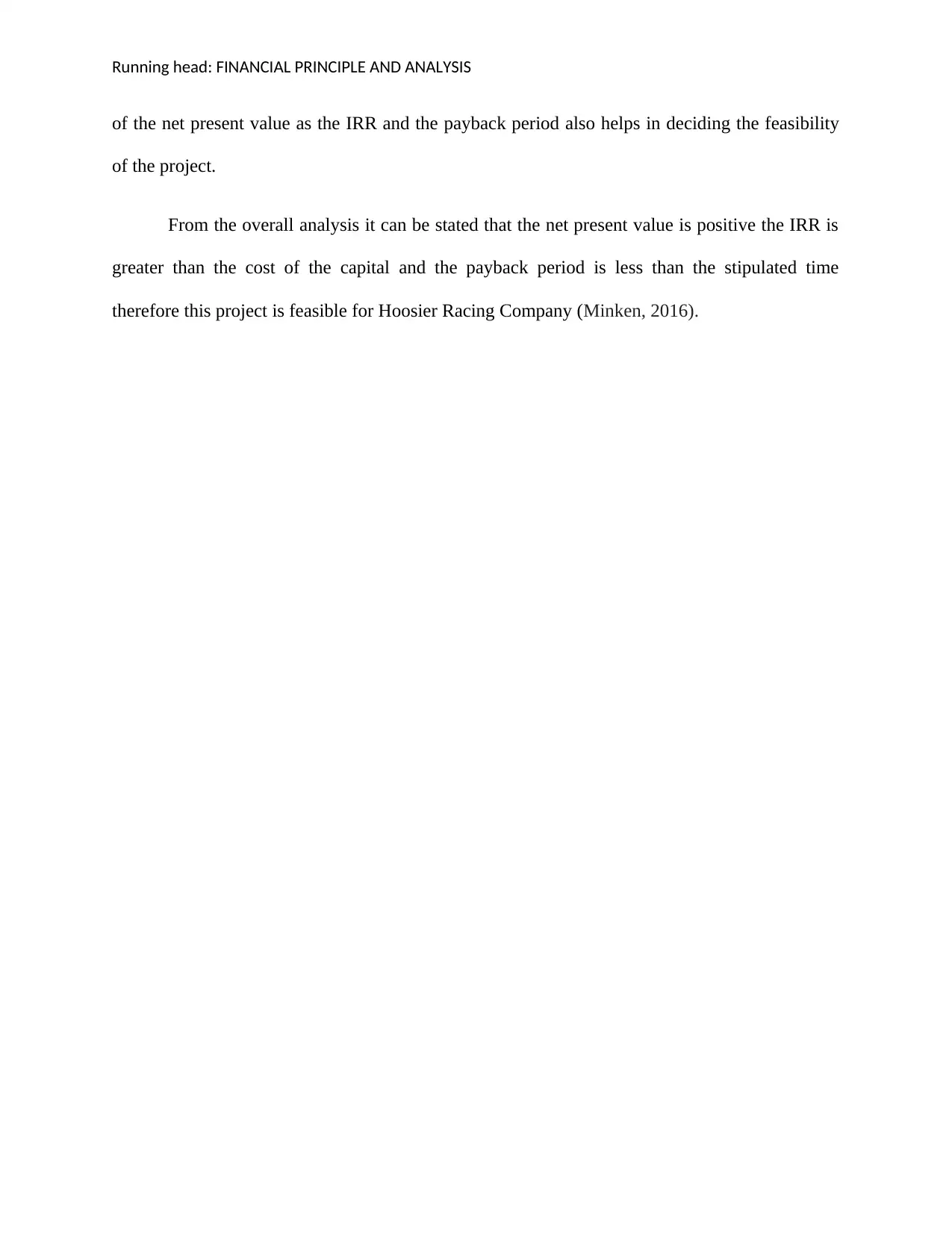
Running head: FINANCIAL PRINCIPLE AND ANALYSIS
of the net present value as the IRR and the payback period also helps in deciding the feasibility
of the project.
From the overall analysis it can be stated that the net present value is positive the IRR is
greater than the cost of the capital and the payback period is less than the stipulated time
therefore this project is feasible for Hoosier Racing Company (Minken, 2016).
of the net present value as the IRR and the payback period also helps in deciding the feasibility
of the project.
From the overall analysis it can be stated that the net present value is positive the IRR is
greater than the cost of the capital and the payback period is less than the stipulated time
therefore this project is feasible for Hoosier Racing Company (Minken, 2016).
Paraphrase This Document
Need a fresh take? Get an instant paraphrase of this document with our AI Paraphraser
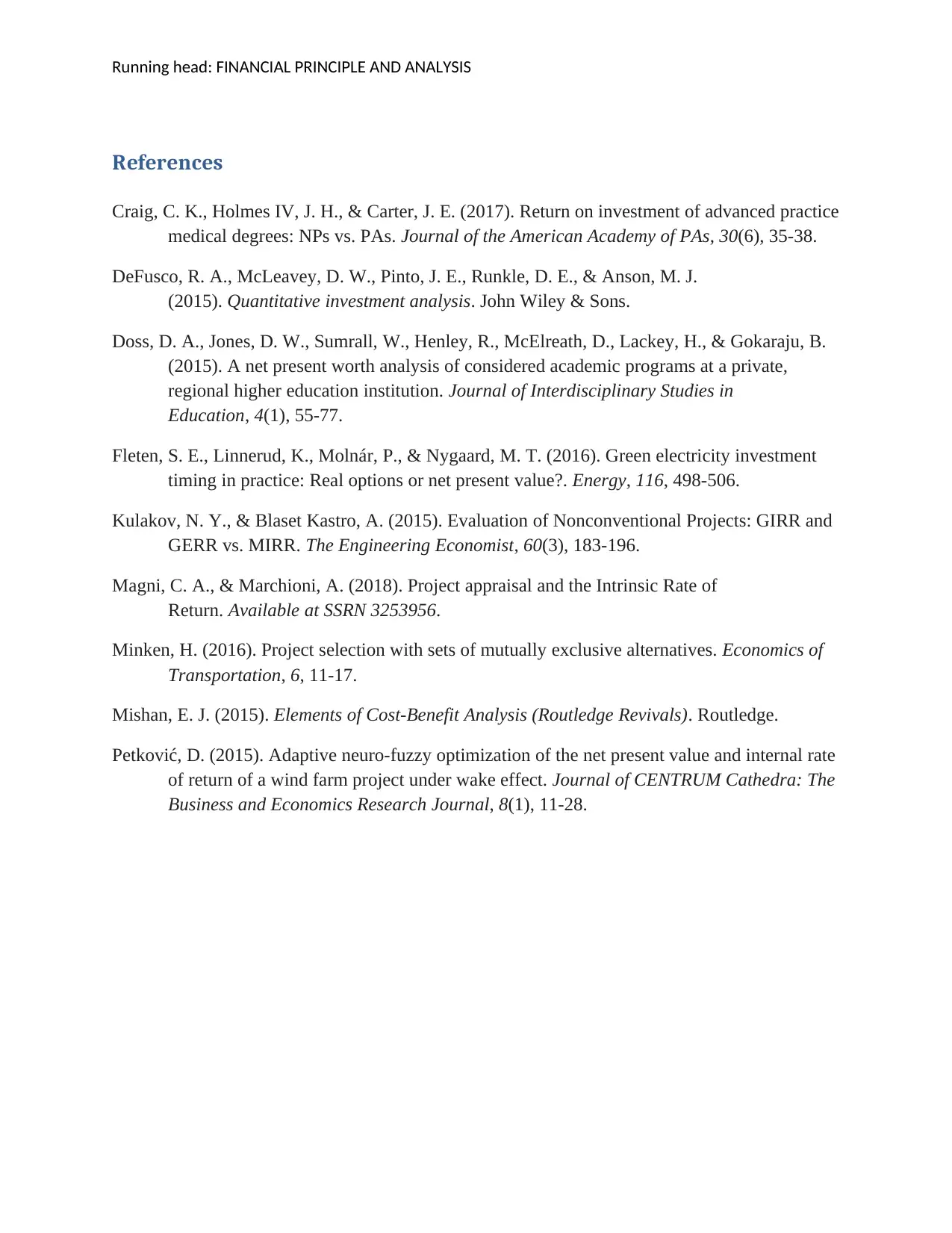
Running head: FINANCIAL PRINCIPLE AND ANALYSIS
References
Craig, C. K., Holmes IV, J. H., & Carter, J. E. (2017). Return on investment of advanced practice
medical degrees: NPs vs. PAs. Journal of the American Academy of PAs, 30(6), 35-38.
DeFusco, R. A., McLeavey, D. W., Pinto, J. E., Runkle, D. E., & Anson, M. J.
(2015). Quantitative investment analysis. John Wiley & Sons.
Doss, D. A., Jones, D. W., Sumrall, W., Henley, R., McElreath, D., Lackey, H., & Gokaraju, B.
(2015). A net present worth analysis of considered academic programs at a private,
regional higher education institution. Journal of Interdisciplinary Studies in
Education, 4(1), 55-77.
Fleten, S. E., Linnerud, K., Molnár, P., & Nygaard, M. T. (2016). Green electricity investment
timing in practice: Real options or net present value?. Energy, 116, 498-506.
Kulakov, N. Y., & Blaset Kastro, A. (2015). Evaluation of Nonconventional Projects: GIRR and
GERR vs. MIRR. The Engineering Economist, 60(3), 183-196.
Magni, C. A., & Marchioni, A. (2018). Project appraisal and the Intrinsic Rate of
Return. Available at SSRN 3253956.
Minken, H. (2016). Project selection with sets of mutually exclusive alternatives. Economics of
Transportation, 6, 11-17.
Mishan, E. J. (2015). Elements of Cost-Benefit Analysis (Routledge Revivals). Routledge.
Petković, D. (2015). Adaptive neuro-fuzzy optimization of the net present value and internal rate
of return of a wind farm project under wake effect. Journal of CENTRUM Cathedra: The
Business and Economics Research Journal, 8(1), 11-28.
References
Craig, C. K., Holmes IV, J. H., & Carter, J. E. (2017). Return on investment of advanced practice
medical degrees: NPs vs. PAs. Journal of the American Academy of PAs, 30(6), 35-38.
DeFusco, R. A., McLeavey, D. W., Pinto, J. E., Runkle, D. E., & Anson, M. J.
(2015). Quantitative investment analysis. John Wiley & Sons.
Doss, D. A., Jones, D. W., Sumrall, W., Henley, R., McElreath, D., Lackey, H., & Gokaraju, B.
(2015). A net present worth analysis of considered academic programs at a private,
regional higher education institution. Journal of Interdisciplinary Studies in
Education, 4(1), 55-77.
Fleten, S. E., Linnerud, K., Molnár, P., & Nygaard, M. T. (2016). Green electricity investment
timing in practice: Real options or net present value?. Energy, 116, 498-506.
Kulakov, N. Y., & Blaset Kastro, A. (2015). Evaluation of Nonconventional Projects: GIRR and
GERR vs. MIRR. The Engineering Economist, 60(3), 183-196.
Magni, C. A., & Marchioni, A. (2018). Project appraisal and the Intrinsic Rate of
Return. Available at SSRN 3253956.
Minken, H. (2016). Project selection with sets of mutually exclusive alternatives. Economics of
Transportation, 6, 11-17.
Mishan, E. J. (2015). Elements of Cost-Benefit Analysis (Routledge Revivals). Routledge.
Petković, D. (2015). Adaptive neuro-fuzzy optimization of the net present value and internal rate
of return of a wind farm project under wake effect. Journal of CENTRUM Cathedra: The
Business and Economics Research Journal, 8(1), 11-28.
1 out of 8
Related Documents
Your All-in-One AI-Powered Toolkit for Academic Success.
+13062052269
info@desklib.com
Available 24*7 on WhatsApp / Email
![[object Object]](/_next/static/media/star-bottom.7253800d.svg)
Unlock your academic potential
Copyright © 2020–2025 A2Z Services. All Rights Reserved. Developed and managed by ZUCOL.




